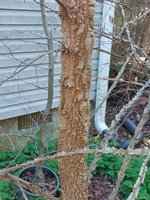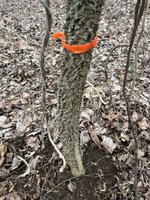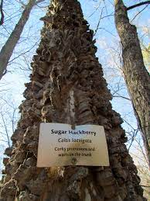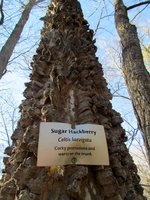You are using an out of date browser. It may not display this or other websites correctly.
You should upgrade or use an alternative browser.
You should upgrade or use an alternative browser.
Hackberry? Not sure
- Thread starter Cmd5235
- Start date
cbroad
Omono
At least in my area, I see some sweet gum with that kind of corky growth (not all of my local ones get that kind of bark though), also winged elm but I don't think that's what you have.
If it has a fat terminal bud, it's probably sweet gum.
If it has a fat terminal bud, it's probably sweet gum.
penumbra
Imperial Masterpiece
Some of those leaves look as though they could be sweet gum.
Cmd5235
Chumono
Not a sweetgum. I have quite a few and know this property- no sweetgum nearbySome of those leaves look as though they could be sweet gum.
JudyB
Queen of the Nuts
Not hackberry, most have smooth skin
penumbra
Imperial Masterpiece
The best clue may be the leaves on the ground.
cbroad
Omono
Yeah, I found a thread on here after I posted where you and some other people were talking about that exact corky growth on sweet gums, so you are aware of that trait. But it is honestly looking like a sweet gum to me.Not a sweetgum
If you can get back out there easily, a picture of a bud will narrow it down for sure.
cbroad
Omono
rockm
Spuds Moyogi
I'd be very surprised if this is a Celtis Laevigata (sugarberry). Sugarberry is a southern U.S. native tree. It doesn't grow much past Southeastern Va. While some limited individual sugarberry might be found outside that range, finding one in the woods randomly 200-300 miles outside that range in Pennsylvania is highly unlikely. That's most likely a sweetgum.
Celtis laevigata
www.fs.usda.gov
Last edited:
JudyB
Queen of the Nuts
Well that sure is interesting, I have never seen corky growth on Sugarberry, but have never seen a mature one. I did read the link rockm posted and it says younger trees are smooth barked. That photo is very corky, the description says mature ones can have corky areas with smooth interspersed. Very cool.
JudyB
Queen of the Nuts
But I bet you have birds, lol...Not a sweetgum. I have quite a few and know this property- no sweetgum nearby
rockm
Spuds Moyogi
Judy brings up an important point--even mature sugarberry aren't really completely covered in warty bark. It can be intermittent even on big sugarberry--even the thick cork on the pic of the sugarberry above has some open spaces between the ridges. I have seen thick cork exactly like the one in your photo on more than a few sweetgum around here. Additionally, it might be instructive to look at the branches. Sugarberry produce berries (or as botanists call them "drupes") They can persist through winter, normally reddish small berries about the size of a pea.
Winged elm is another good guess for this tree as well.
Winged elm is another good guess for this tree as well.
penumbra
Imperial Masterpiece
With baited breath..........
jandslegate
Shohin
I agree. Sweetgums are quite prolific, heh.But I bet you have birds, lol...
cbroad
Omono
Took a couple pics of some of my potted wing elms for comparison:




The younger wood on these definitely have more corking, but becomes more craggy as they weather and mature.
A picture of a younger branch on the OPs should also narrow it down, at least between sweet gum and winged elm (I'm not familiar with sugarberry). The wings on winged elm are pretty hard to confuse with other trees, sweet gums start out as more warty.




The younger wood on these definitely have more corking, but becomes more craggy as they weather and mature.
A picture of a younger branch on the OPs should also narrow it down, at least between sweet gum and winged elm (I'm not familiar with sugarberry). The wings on winged elm are pretty hard to confuse with other trees, sweet gums start out as more warty.
Cmd5235
Chumono
I'll try to get out there this week after work to grab some photos
GGB
Masterpiece
winged elm and southern hackberry don't grow in our area. Northern hackberry is a good guess but the bark doesn't look quite right
GGB
Masterpiece
if you can get a good photo of the twigs and buds I can tell you sure sure if it's celtis occidentalis
Cmd5235
Chumono
Similar threads
- Replies
- 4
- Views
- 522
- Replies
- 6
- Views
- 492
- Replies
- 1
- Views
- 457





